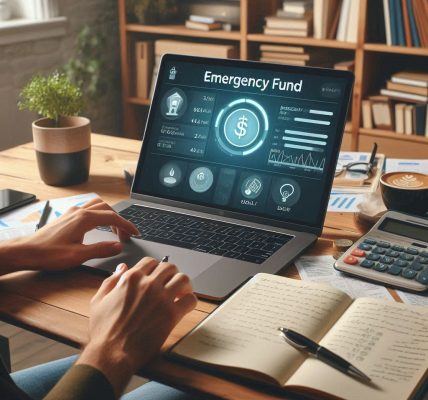Life is unpredictable. No matter how well we plan or budget, unexpected expenses can arise at any time—whether it’s a sudden medical emergency, a job loss, a major car repair, or an urgent home repair. These unplanned events can cause significant financial strain if you don’t have the right resources to cover them. That’s where an emergency fund comes into play.
In this blog, we’ll explore the importance of having an emergency fund, why it should be a priority, and practical steps on how to build one that will give you peace of mind and financial security in times of need.
What is an Emergency Fund?
An emergency fund is a separate savings account that is used specifically for unexpected expenses or financial emergencies. It’s not meant for planned purchases like vacations or a new phone but rather for events that fall outside the scope of your normal budget. The purpose of an emergency fund is to cover unexpected costs without relying on credit cards, loans, or going into debt.
Some examples of when an emergency fund comes in handy include:
- Medical emergencies (unexpected health issues, treatments, or hospital visits)
- Car repairs (unexpected breakdowns or accidents)
- Home repairs (such as plumbing issues, broken appliances, or storm damage)
- Job loss or income disruption (when you are unable to work for a period)
Why is an Emergency Fund So Important?
1. Financial Security and Peace of Mind
One of the most significant benefits of an emergency fund is the financial security it provides. Knowing that you have a cushion to fall back on when unexpected expenses arise reduces stress and gives you peace of mind. Without an emergency fund, you risk resorting to credit cards or loans, which can lead to debt and financial instability.
2. Avoiding Debt and High-Interest Loans
Without an emergency fund, people often rely on credit cards or high-interest loans to cover urgent expenses. This can quickly spiral into debt, as interest charges accumulate. An emergency fund helps you avoid this by allowing you to pay for emergencies with your savings, keeping you out of the debt trap.
3. Protecting Your Financial Goals
If you don’t have an emergency fund, you may need to dip into your long-term savings or investment accounts to cover unexpected expenses. This can derail your progress toward important financial goals like retirement or buying a home. Having a separate emergency fund ensures that you don’t have to sacrifice your future goals to handle unexpected events.
4. Flexibility During Job Transitions
In case of a job loss or career change, an emergency fund provides the flexibility to take time to find the right job without the pressure of immediate financial strain. It allows you to manage living expenses while you search for new employment, protecting you from needing to accept any job just for the sake of income.
How Much Should You Save for an Emergency Fund?
The amount you need to save for an emergency fund depends on your lifestyle, expenses, and personal preferences. However, financial experts generally recommend saving between 3 to 6 months’ worth of living expenses. This is typically enough to cover your basic needs (such as housing, food, transportation, and healthcare) in case of an emergency.
To determine how much you need:
- List your monthly essential expenses (rent, utilities, groceries, transportation, insurance, etc.).
- Multiply this amount by 3 to 6 months to determine your target emergency fund goal.
For example, if your monthly expenses are $3,000, your emergency fund goal would be:
- $3,000 x 3 = $9,000 (for 3 months)
- $3,000 x 6 = $18,000 (for 6 months)
Start with a goal that is manageable for your current situation and increase it over time.
How to Build Your Emergency Fund
1. Set a Clear Goal
The first step to building an emergency fund is to set a clear, realistic savings goal. As mentioned earlier, aim for 3 to 6 months of living expenses. Knowing exactly how much you need will make the process more concrete and less overwhelming.
2. Open a Separate Savings Account
To avoid dipping into your emergency fund for non-emergency purposes, open a separate savings account that is exclusively for emergencies. Choose an account that is easily accessible in case of need but not so easy to access that you’re tempted to withdraw for non-emergency spending.
Look for a high-yield savings account that offers interest on your savings, so your emergency fund grows over time. Online banks often offer higher interest rates compared to traditional banks.
3. Automate Your Savings
One of the easiest ways to build an emergency fund is to automate your savings. Set up an automatic transfer from your checking account to your emergency fund account every payday. Treat this transfer as a non-negotiable expense, just like paying bills or rent. Even saving a small amount each month will add up over time.
Start with what you can afford, even if it’s just $50 or $100 per month, and increase the amount as you pay off debts or increase your income.
4. Cut Back on Non-Essential Expenses
To build your emergency fund faster, consider cutting back on non-essential spending. Review your monthly expenses and look for areas where you can trim down:
- Cancel unused subscriptions (streaming services, gym memberships, etc.).
- Limit dining out and cooking at home more often.
- Avoid impulse purchases by sticking to a shopping list.
Redirect the money you save from these cutbacks into your emergency fund.
5. Use Windfalls or Bonuses
If you receive any unexpected money, such as a tax refund, bonus, or gift, consider using a portion of it to contribute to your emergency fund. While it may be tempting to spend this “extra” money, using it to build your emergency fund can have a much longer-lasting impact.
Where to Keep Your Emergency Fund
Your emergency fund needs to be both accessible and safe. The goal is to be able to quickly access the funds when you need them, but also to avoid spending them impulsively. Here are a few options to consider:
- High-yield savings account: Offers easy access and earns interest.
- Money market account: A safe option with a slightly higher interest rate.
- Certificate of Deposit (CD): Not ideal for emergencies but can be considered if you have a larger emergency fund and are willing to lock away some money for a fixed term.
Final Thoughts
An emergency fund is an essential part of your financial safety net. It helps you manage life’s unpredictable events, reduce stress, and avoid the burden of debt. By setting clear savings goals, automating your contributions, and cutting back on unnecessary spending, you can build an emergency fund that provides security and peace of mind when you need it most.




